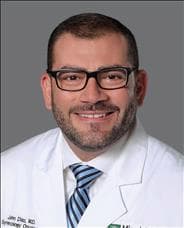Uterine Transposition Surgery Improves QOL Through Fertility Preservation
A new surgical option of uterine transposition may help preserve fertility for women who have cancers of the pelvic region.
John Paul Diaz, MD
Miami Cancer Institute

The new surgical technique of uterine transposition allows women undergoing radiation therapy to the pelvic field to attempt to preserve their fertility. John Paul Diaz, MD, spoke about how this new technique could be a pivotal operation to protect quality of life.
Diaz, chief of gynecologic oncology, director of robotic surgery, director of the Center of Excellence in Minimally Invasive Gynecologic Surgery at Baptist Health, and lead physician for Clinical Trials in Gynecologic Oncology at Miami Cancer Institute, highlighted that this surgery is suitable for any patient with colorectal or gynecologic cancers who may be receiving radiation to the affected areas.
The surgery, which moves the uterus into the abdominal wall away from the affected radiation area, is one way that surgeons are beginning to think outside of the box, according to Diaz.
CancerNetwork®: What are the specific surgical techniques involved in uterine transposition, including the methods used to temporarily relocate and secure the uterus?
Diaz: The surgical techniques used for uterine transposition are quite simple and very similar to a hysterectomy. The idea is to begin by opening the retroperitoneum. We want to make sure that we avoid touching any of the blood supply to the uterus, like the infundibulopelvic ligament. That’s what’s going to preserve the uterus after the fact. The difference here is we’re going to preserve the uterus, as opposed to removing it during a hysterectomy. Once we get down to the main blood supply of the uterus, the uterine arteries are ligated, and the uterus and cervix are released from the vagina. We then mobilize the uterus up into the abdomen, and we then stitch it up to the anterior abdominal wall, thereby taking it out of the radiation field so that patients can safely receive the radiation they need to treat their pelvic tumor but preserve their fertility and hopefully carry a future pregnancy.
This surgery occurred with the collaboration of Memorial Sloan Kettering (MSK) Cancer Center. How did this come about?
Diaz: At Baptist Health, South Florida, we’re part of the MSK Alliance. I trained at MSK and continued to keep in close contact with a lot of the physicians and surgeons there, including my friend and mentor, Mario M. Leitao, Jr., MD, FACOG, FACS, who has the largest series in the United States performing uterine transpositions. When I had a patient who would be a candidate for this procedure, I discussed the case with Leitao and went up to MSK to observe the technique in the operating room. When it came for us to do our first procedure, Leitao came down to South Florida and observed us in the operating room. This collaboration has been great to help expand the number of patients who could benefit from this surgical technique.
What are the outcomes you saw with the 2 patients who underwent this procedure?
Diaz: We’ve had 2 patients who have undergone this procedure here in South Florida. Our first patient has completed her adjuvant radiation therapy, and we completed phase 2 of the procedure, which is now to move the uterus and the ovaries back into the pelvis, and re-anastomosis to the vagina. That was a very successful procedure. The patient is currently 3 months post-op and is doing very well, and now we’re eagerly awaiting the opportunity for her to get pregnant in the future. Our second patient is currently receiving her radiation therapy, and the plan is to proceed with stage 2 of the procedure later this year.
What sets uterine transposition apart from other fertility preservation methods in gynecologic care?
Diaz: For some time, we’ve been looking at how can we treat these cancers for women and preserve their fertility. [There are] different things that we’ve tried in the past, but when [patients are] going to receive pelvic radiation, we would mobilize the ovaries out of the radiation field, and now at least try and preserve the ovaries so they can contain their estrogen production and possibly allow them for a genetic child in the future with a surrogate carrier.
We’ve also done other techniques, such as a radical trachelectomy described in the first series over 15 years ago. We continue to try and adapt our treatments for these young patients, where we can successfully treat their cancers but preserve fertility. The interesting part about this technique is we’re preserving the entire uterus. These patients can receive their pelvic radiation and then be able to carry a child in the future. There’s no radiation technique now that can safely be performed to preserve this uterus function. This is an exciting and big change in the treatment of [patients with] these cancers.
How can you best identify candidates for this procedure, and which cancer types or stages is it most useful for?
Diaz: Candidates for this procedure are women who have some pelvic tumor, either colorectal cancer or vaginal cancer, in which they’re going to require pelvic radiation that would otherwise sterilize the uterus, and [they may be] unable to carry a pregnancy in the future. These tend to be younger women who still want to preserve their fertility in the future. There are cancers or cancers that can be potentially treated and cured with a combination of pelvic radiation. We mobilize the uterus out of that radiation field and safely allow them to get the cancer treatment that they need, and then bring the uterus back into its natural [home] in the pelvis so they can hopefully carry a pregnancy in the future.
Were there any challenges encountered during the development or implementation of this procedure? How did you overcome them?
Diaz: One of the biggest challenges with this procedure, or any of these procedures, is just thinking outside the box. As surgical oncologists, our priority has always been, and rightfully so, to treat the cancer. When we first did this, the idea was with a radical surgery, the more tissue around the tumor that was negative, the better the oncologic outcomes would be. We’ve learned over time that we can continue to keep great oncologic outcomes but tailor our techniques to improve outcomes for women. We saw this in the evolution of the management of breast cancers, from these very radical surgeries to lumpectomies with sentinel lymph nodes. This has been patient-driven. The patients have been forcing us as surgeons to come up with better techniques where we can treat the disease but also give them a better quality of life afterward. This is no different. The procedure itself, surgically, is very simple. It’s something that we all would feel comfortable performing. It’s just a matter of thinking about it in a certain way, and once you see it done, you realize that this can be done and hopefully applied to many women to preserve their future fertility.
How effective is this procedure in preserving fertility? Are there any limitations that may impact the success of future pregnancies?
Diaz: This is a novel technique. There have only been a handful of cases that have been done around the world, and so our experience continues to grow. In the initial experience in Brazil, about 75% of their surgeries were successful. In other words, the uterus was preserved and was functioning. That number has now improved as we continue to collaborate with our partners around the world and share our surgical techniques. In that initial collaboration, we saw 3 of the 4 women who attempted fertility to have a successful pregnancy, and so that’s encouraging.
We also have to remember we’re dealing with cancer here. We’re dealing with a novel surgical technique. Some of these patients, unfortunately, may not have a successful treatment of their cancer, and so fertility then may become secondary as they go on to treat this progressing disease. When removing the uterus from the normal area, the blood supply can sometimes be compromised as you do this. We’re starting to learn more and more, but success rates have continued to improve with greater experience.
What are some key short- and long-term outcomes for patients who undergo this procedure?
Diaz: One of the short-term things that we’re looking for immediately in the operating room is whether the uterus is perfusing well. We use a dye called indocyanine [ICG] green that we inject, and we see the uterus absorb that dye and become green. That’s an indication that it’s perfusing well. In the short term, we want to see if there are no post-operative complications. We want to continue to see good perfusion, good outcomes of this uterus, and the successful prescribed cancer treatment that these patients are undergoing. We can then go back and re-implant the uterus back into its normal anatomical position. Obviously, the ultimate long-term success is for the patient to be cured of their disease and to go on to have a successful live birth. That takes time and patience for both the patient and us, but this is what we’re looking for, and we are excited about granting this opportunity to future patients.
Have you experienced any challenges trying to raise awareness for this procedure?
Diaz: One of the challenges is that providers need to be aware that this is even an option. We’re going to those providers who are seeing these patients. We’re going to our colorectal surgeons, our colleagues in rectal cancer and colon cancer, to make them aware that this may be an option for their young patients because they’re the ones who need to identify these patients and ultimately refer them to someone like us. We’re also working to share knowledge about this procedure. Hopefully, more surgeons around the United States can offer this to their patients and their colleagues. That’s been the biggest challenge: how do we get this word out? How do we educate the providers who are first seeing these patients so they can be referred to someone who feels comfortable performing this procedure?
What are the next steps for this procedure?
Diaz: Some of the next steps with this procedure are to expand access to patients and to let other doctors know that this is even an option. This is still novel, although the first description of this was almost 10 years ago. We’re only starting to hear about this in the United States, so [it is important to] spread that information to those physicians who are first seeing these patients with these pelvic tumors. They can educate these patients about this fertility option before they initiate their cancer treatments, and then continue to work and develop new and novel techniques. Some of these great advances [include] radical trachelectomy to preserve the uterus or the uterine transposition. This was again focused on improving patients’ post-cancer diagnosis so they could retain their fertility.
Is there anything else you would like to highlight?
Diaz: It’s exciting that we’re thinking outside the box, and that we’re moving a reproductive organ outside the field of radiation so that women can preserve fertility. We’re doing this successfully. This is something that, a few years ago, we wouldn't have even thought about, and so it’s exciting to see this. We’re seeing better outcomes for patients, especially at a time when we're seeing more and more young women who are being diagnosed with pelvic tumors.
